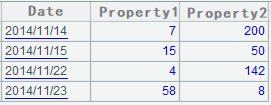Order-based Calculations – Get Specified Records and their Next Ones
【Question】
| Date |
Property1 |
Property2 |
| 2014/11/12 |
4 |
88 |
| 2014/11/13 |
5 |
33 |
| 2014/11/14 |
7 |
200 |
| 2014/11/15 |
15 |
50 |
| 2014/11/16 |
2 |
66 |
| 2014/11/17 |
4 |
22 |
| 2014/11/18 |
2 |
70 |
| 2014/11/19 |
58 |
1 |
| 2014/11/20 |
51 |
53 |
| 2014/11/21 |
4 |
2 |
| 2014/11/22 |
4 |
142 |
| 2014/11/23 |
58 |
8 |
I want a MySQL query to find out the records where Property2 value is greater 100 and their next records. The expected result:
| 2014/11/14 |
7 |
200 |
| 2014/11/15 |
15 |
50 |
| 2014/11/16 |
4 |
142 |
| 2014/11/17 |
58 |
8 |
【Answer】
MySQL doesn’t support window functions. Subqueries are needed to complete this order-based calculation. The query can be like this: select * from t0055 t1 where Property 2 >100 or Date in (select Date +1 from t0055 where Property 2>100).
This query is based on continuous dates. If dates are not continuous, we need to create sequence numbers for them with a sub-subquery.
SPL (Structured Process Language) supports order-based calculations. It’s simple to handle both continuous and discontinuous dates. For your problem, here’s the SPL script:
| A |
|
| 1 |
$select * from t0055 order by Date |
| 2 |
=A1.pselect@a(Propety 2>100) |
| 3 |
=A1(A2.conj([~,~+1])) |
Below is the final result:

The SPL script can be embedded into an application through esProc JDBC interface. See How to Call an SPL Script in Java.
SPL Official Website 👉 https://www.scudata.com
SPL Feedback and Help 👉 https://www.reddit.com/r/esProc_SPL
SPL Learning Material 👉 https://c.scudata.com
SPL Source Code and Package 👉 https://github.com/SPLWare/esProc
Discord 👉 https://discord.gg/cFTcUNs7
Youtube 👉 https://www.youtube.com/@esProc_SPL


